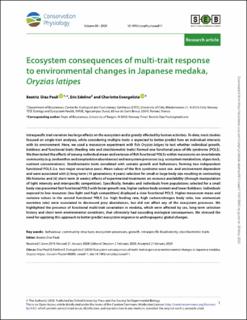Ecosystem consequences of multi-trait response to environmental changes in Japanese medaka, Oryzias latipes
Journal article, Peer reviewed
Published version

View/
Date
2020Metadata
Show full item recordCollections
- Department of Biological Sciences [2216]
- Registrations from Cristin [9489]
Original version
Conservation Physiology. 2020, 8 (1), coaa011. https://doi.org/10.1093/conphys/coaa011Abstract
Intraspecific trait variation has large effects on the ecosystem and is greatly affected by human activities. To date, most studies focused on single-trait analyses, while considering multiple traits is expected to better predict how an individual interacts with its environment. Here, we used a mesocosm experiment with fish Oryzias latipes to test whether individual growth, boldness and functional traits (feeding rate and stoichiometric traits) formed one functional pace-of-life syndrome (POLS). We then tested the effects of among-individual mean and variance of fish functional POLSs within mesocosms on invertebrate community (e.g. zoobenthos and zooplankton abundances) and ecosystem processes (e.g. ecosystem metabolism, algae stock, nutrient concentrations). Stoichiometric traits correlated with somatic growth and behaviours, forming two independent functional POLS (i.e. two major covariance axes). Mean values of the first syndrome were sex- and environment-dependent and were associated with (i) long-term (10 generations; 4 years) selection for small or large body size resulting in contrasting life histories and (ii) short-term (6 weeks) effects of experimental treatments on resource availability (through manipulation of light intensity and interspecific competition). Specifically, females and individuals from populations selected for a small body size presented fast functional POLS with faster growth rate, higher carbon body content and lower boldness. Individuals exposed to low resources (low light and high competition) displayed a slow functional POLS. Higher mesocosm mean and variance values in the second functional POLS (i.e. high feeding rate, high carbon:nitrogen body ratio, low ammonium excretion rate) were associated to decreased prey abundances, but did not affect any of the ecosystem processes. We highlighted the presence of functional multi-trait covariation in medaka, which were affected by sex, long-term selection history and short-term environmental conditions, that ultimately had cascading ecological consequences. We stressed the need for applying this approach to better predict ecosystem response to anthropogenic global changes.
